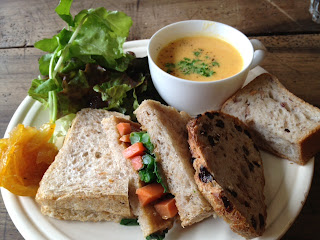Looking around online and at the listings for 賃貸店舗/chintai tenpo/rental
shops in 不動産/fudosan/real estate agent windows, you'll see shop rent in Tokyo
varies wildly. You can sometimes find a space listed for just above 100,000 JPY,
but it’s likely to be a cubby-hole little space far away from a station.
More reasonably, you can expect to pay rent starting at about 150-200,000
JPY for the lower end small spaces (maybe 9 tsubo/30 m2), and average rent on
medium sized spaces above 20 tsubo/60m2 appears to range from 300-500,000 JPY
for nothing too fancy (slightly fancier, more prominently placed and you're
talking in millions of yen a month in rent). Fudosan often list the size of a
space in 坪/tsubo instead of metres (here’s a converter), sometimes you’ll see
the price per tsubo, to allow you to compare the relative cost of a few spaces.
Apart from size, price will also depend on location, but also things like
distance to the metro station or 商店街/shotengai/shopping street, age of the
building, and the wishes of the owner. That last point is a bit unpredictable,
as even in the current 'buyers (well actually renters) market' landlords may not
be open to negotiation on price despite their property being vacant for a long
time, because "that's the price, and it's a good one so I won't change it" as I
was told upon renewing the lease on my last apartment. (I've since moved out to
a nicer place and pay less, hurrah!) On the other hand, whims of the owner can
also play in your favour.
When you’re looking on fudousan websites use the 店舗検索/tenpo kensaku/shop
search option or section of their site to avoid seeing listings for private
apartments and office space. Note that even in the shop search section of some
sites, only some of the listings are suitable for use as 飲食店/inshokuten/food
businesses.
Here are some fudosan sites you could try:
Taking an Azabu Juban fudousan site Furusato House as an example, you can see that spaces close to the main shopping street and main roads (top picture) are generally more expensive than something a bit further out (bottom picture). Both of these examples are a bit on the pricey side compared to less trendy areas of Tokyo.
 |
| On the main road in Azabu Juban, B1 space 1 million yen rent |
 |
| Moto Azabu area 407,000 yen rent |
Notice that sometimes new buildings have surprisingly low rents. In the
image below there is a 4th floor 45m2 space listed right on the Azabu Juban
shopping street just 4 minutes walk from the station for 325,200 JPY. An agent
once explained to be careful about this, as it is often a way of filling a new
building with tennants quickly and that when it comes time to renew the
contract, the rent may become much higher. In this example the contract is
fixed-term for 3 years, and so I'm assuming the rent won't change for the
tennants for those 3 years.
Start-up money for renting a shop space or an office is considerably higher
than when you’re renting an apartment. Again it’s very much case by case, but
where renting your own apartment in Tokyo generally requires 2 month’s rent as
deposit it isn’t unusual to see upwards of 6 months rent (賃料/chinryou) required
as a deposit (保証金/hoshoukin) on a commercial space. Add to that your agent’s fee
(仲介手数料 /chuukai tesuuryou), advance rent, key money, insurance, monthly
management fees (管理費/kanrihi), and any gift money (礼金/reikin) etc. and you could easily be looking at needing over a year’s worth of rent in order to move in.
I would estimate then that at the very minimum, with a small shop space at
a rent of around 200,000 JPY and assuming no gift money, you’d need to have at least 2-million yen before factoring in the cost of doing up the space, incorporation,
supplies and all the other expenses of setting up a business. It’s also worth
pointing out that owners will usually stipulate a depreciation fee
(償却/shoukyaku) which is a certain percentage or number of month’s rent worth of
the deposit that you will not be refunded – I’m still learning the details, but
it seems to be that if applied as a percentage, then this in effect eats away
gradually at the amount of returnable deposit each year, if is written as “2
months rent” then this will be the fixed amount you are guaranteed to lose from
your deposit upon moving out, with any cleaning/damage fees to be added on
top.
Another option you could try is to use something like http://www.inshokuten.com/ or http://www.inuki-info.com/ to find spaces of businesses that have closed down, that are already fitted out with much of the equipment you would need, and presumably want a quick agreement. If you visit Tokyo Business Entry Point, the gentlemen there will be able to put you in touch with a couple of real estate agents who deal specifically in this type of arangement. It could be a way to cut some of the initial cost.




















































